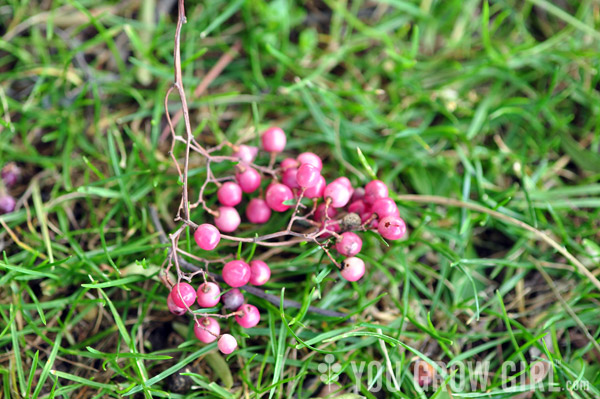
A few years back, we spent a week at Rancho la Puerta, a spa in Tecate, Mexico, an hour or so south-east of San Diego, California. I had a great time exploring the landscape of the coastal Baja California desert chaparral and the many fascinating cultivated and wild plants that thrive there. I didn’t do a ton of research before we left so many of the plants were a surprise. One of the biggest surprises was the Peruvian pink pepper tree (Schinus molle) next to our cabin.
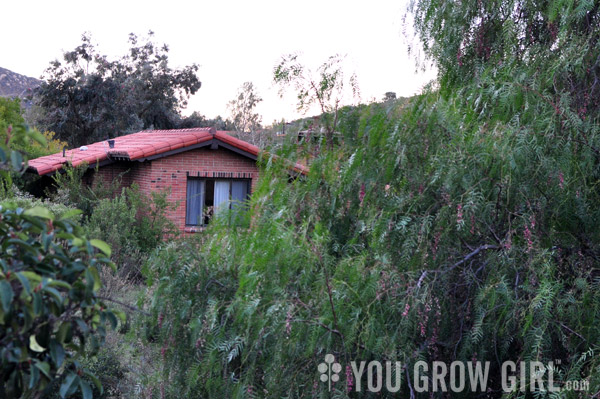
On the right: The Peruvian Pink Pepper Tree (Schinus molle) found next to our cabin. It’s dangling habit reminds me of a willow tree.
It was Davin who spotted the clusters of pretty pink berries strewn all over the ground. Here in Toronto pink peppercorns aka pink pepper — no relation to the tropical vine that produces black peppercorns (Piper nigrum) — are almost a luxury spice, some exotic treat that comes packaged in small, over-priced jars. The hard seeds are spicy like black peppercorn, but come packaged inside a pinkish-red papery husk that is fruity and aromatic with a hint of pine. We often use the delicately flavoured spice at home in lieu of harsher black pepper. It’s become quite popular recently and I’ve noticed it appearing more often in new cookbooks and as flavouring in premium chocolates. So when Davin came running into our cabin with his hands full of the berries, I didn’t believe they were the real deal. Surely no one would allow heaps of expensive foodstuffs to just sit there on the ground like that? No way were we going to taste them until I knew more.
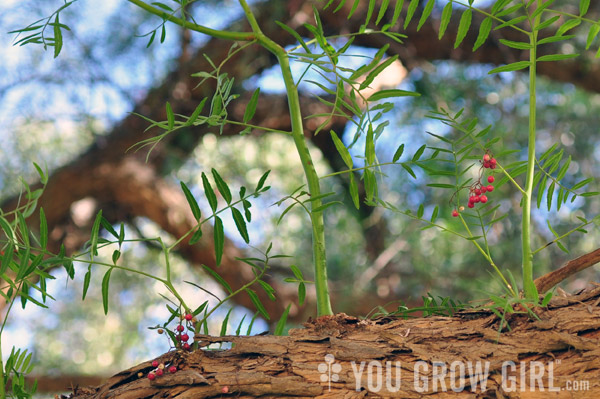
Peruvian pink pepper tree (Schinus molle) are considered safe to eat.
Later that week, we did a little research in the spa library as well as on our phones, and discovered that it was indeed edible pink peppercorn that he found. It turned out that there are two species of trees growing on the property. The first tree we found was Peruvian pink pepper tree (Schinus molle), a native of Peru that is now growing wild through warmer regions of the US including California, Arizona, Florida, and Texas. This is the classic pink peppercorn and it is generally considered to be safe to eat, and thought not to contain the urushiol-type allergens found in the Brazilian pink pepper [see below].
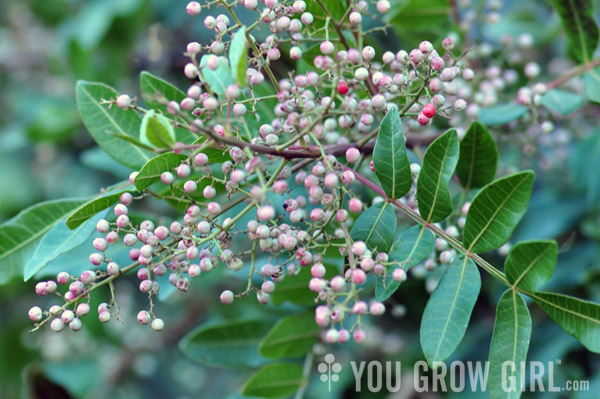
Brazilian pink pepper tree (Schinus terebinthifolius) berries are generally not considered to be safe for eating. Please use caution before attempting to eat these. Just touching the plant can cause a skin reaction, especially if out in the hot sun.
The second, Brazilian pink pepper tree (Schinus terebinthifolius) is a large ornamental shrub that has made its way into California, Texas, and Florida. While many people claim to eat it without incident, there are many more that say that the berries as well as all parts of the plant can cause severe allergic reactions (both ingesting the berries and touching the plant) as well as gastroenteritis and vomiting. Chemically, they contain urushiol, an oily allergen found in poison ivy, poison sumac, and others in the Anacardiaceae Family.
Incidentally, I found reference to this species in a book in my personal library, “Herbs and Spices: The Cook’s Reference.” This book has it listed on page 159 as an edible. Still, with my history of allergies to cashews, mangos, and other plants in the poison ivy/sumac family (Anacardiaceae), I don’t plan to test my fate with this species. I have absolutely no problem with the other.
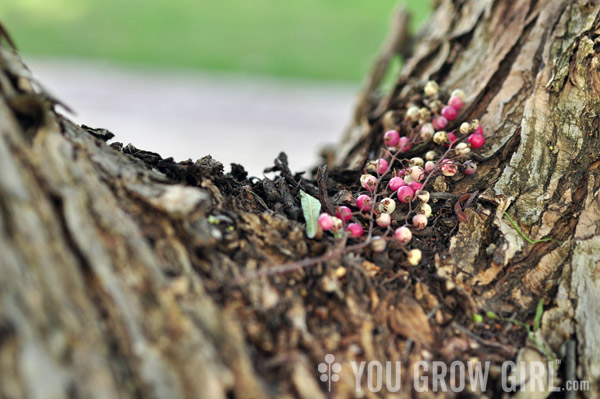
Identifying the Difference
As you can see in the above photos, the leaves of the Brazilian pink pepper tree (Schinus terebinthifolius) are rounder than the narrow, elongated leaves of the edible Peruvian type. Their difference is quite easily discernible even when they are not set side-by-side. However, the berries themselves look much alike. They both have dark;y coloured, hard seeds that are covered by pinky-red, brittle, paper-like husks. The difference is primarily in their size. The unsafe Brazilian type are smaller. You really should rely on the leaves to identify their difference in the field.
Processing and Storing
Back at home, I laid the berries out to dry on a piece of newsprint. Once dry, I stored them whole in a large glass jar. It’s been a few years and they’re still great! We crush them with a mortar and pestle to release their flavour directly before using.
We have a MASSIVE Schinus molle tree in our front yard. Here in California, they’re known as California Pepper Trees (hey!).
Three words to describe it: Messy. Messy. MESSY!
Plus, it keeps playing host to various bee colonies. Unfortunately, the hives are INSIDE the tree (so the honey is inaccessible – boo!), and the bees have gotten more aggressive, over time. This will probably be the last year that we pay an apiarist to trap/move the bees. After that, we may have to have the tree removed because hubbie is allergic to bee stings. I’ll try to gather some of the berries and dry ’em, though. I wasn’t sure if they were edible – so thanks for confirming!
My rule when trying anything new is to go easy at first just in case you do have a reaction. I am fine with these and I have serious trouble with all kinds of foods in this family…. but you never know. In fact, I made bok choy with dinner last night that was sautéed with ginger, shallots, and these same pink peppercorns!
Brazilian pepper is a horribly invasive tree in Florida and in coastal regions of Texas. Much money is spent on eradicating it from natural areas.
That said, I didn’t realize there was another Schinus species. I’ve not seen the Peruvian version and I wonder about its invasiveness too. Thanks for the information!
I also live in Southern California (Los Angeles area) and pepper trees are quite common as the parkway planting. A few years ago I saw some Hispanic women collecting the berries when I was taking a walk and asked them what they were used for. Their English was minimal but they did convey with hand motions and some words that they were using them to relieve pain and swelling (topically not orally). They are in the whole peppercorn mix I grind for use everyday so now i must experiment. I had no idea these were the same berries. Thank you!
So glad I saw this! I keep meaning to do more research – you just saved me a lot of time :) I have two California peppers in my yard with lots of beautiful berries. I’ll be bringing some in to cook with today! Thank you for sharing ~